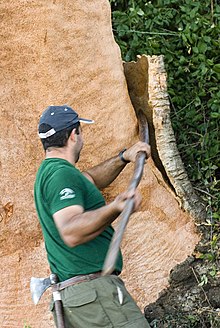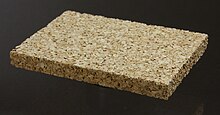cork


The outermost tissue layer of the periderm is called cork (phellem) . It is formed from the cork cambium (phellogen).
In everyday use, the term cork refers to the material from the bark of the cork oak ( Quercus suber ), from which corks are primarily extracted. Cork is also extracted from the bark of the Asian Amur cork tree ( Phellodendron amurense ). The world's largest cork producer is Portugal .
Education and characteristics
education
Cork is formed by phellogen (cork cambium) and serves as a secondary closing tissue , especially in those places where the epidermis and the cortex cannot follow the expansion of the circumference of the stem axis during secondary growth in thickness . The phellogen forms cork on the outside and a thin layer of parenchymatic cells on the inside , the phelloderm (cork bark), which can also contain chloroplasts . Phellem, phellogen and phelloderm are collectively referred to as periderm .
The cork that forms is species-specific and only a few cell layers thick in most plants, as is the case, for example, with the white cork flags on birch trunks . In the case of a few species, especially the cork oak , on the other hand, cork layers that are centimeter thick form due to the long activity of the phellogue. These are then divided into annual rings. In the euonymus ( euonymus ) and some other species, cork strips are formed on young branches.
The formation of specific cork cells takes place through the accumulation ( accumulation ) of suberin , a lipophilic and water-impermeable biopolymer . This also ensures the hydrophobic (water-repellent) effect of the cork cells. As a lipophilic substance, suberine (and thus cork) can be made visible under a light microscope using Sudan-III-glycerol. After the wall formation is complete, the cells die and fill with gas. In addition, tannins can be stored as protection against invading insects, which lead to a brown color.
properties
The cork, which consists of air-filled dead cells, is interspersed with lenticels for the exchange of substances (water / gas) , which run through the natural hard foam. These cork pores allow the underlying epidermis to breathe. It has no intercellulars . Cork is hydrophobic, very elastic and hardly combustible. The thermal conductivity of cork is very low, which makes it suitable as an insulating material . It can be used in a wide temperature range from −200 to +120 ° C.
The transpiration is very limited already by a thin layer of cork.
use
application areas
Cork is economically interesting for numerous applications: in fishing as a swimmer on rods and nets, as a sealing material in machines and devices, as a bottle cap, as a pin board, as a floor covering, in wind instrument construction, as orthopedic shoe insoles, for yoga blocks, in the textile sector for clothing , Bags and purses as well as construction and thermal insulation.
history
The bark of the cork oak has been peeled and processed with cutting axes from trunks and main branches in the Mediterranean region , especially in central Italy and Spain or the then Roman province of Hispania and today mainly in the south of Portugal , since the 2nd century AD . A cork oak is peeled for the first time at the age of 25. The cork bark then grows back and is peeled every 9 years, up to 17 times in total. The cork oak usually reaches an age of more than 200 years. Originally, cork cutters were busy processing it.
More than half of the world's cork trade is now carried out in Portugal , where over 30% of the cork oaks grow worldwide.
processing
The first time it is peeled, a rough, resin-rich cork bark is produced, which is suitable for the production of pure, expanded dark brown cork panels (without the addition of artificial binders), such as those used as a natural building material for thermal insulation. After that, the secondary cork bark can be harvested every 8 to 12 years. It is low in resin and largely homogeneous, which is why it is suitable for machine processing. The secondary cork is mainly used to manufacture bottle corks and a number of other industrial products. The Portuguese company Corticeira Amorim is the global market leader in the manufacture of cork products .
The remains of the bottle cork production are ground into light brown granules. This secondary cork granulate can be glued with latex , polyurethane and other adhesives in a vacuum and / or under mechanical pressure. Such artificial agglomerate cork can be used to manufacture products with higher strength (such as champagne corks) or - from blocks cut into slices - floor coverings. Due to its low thermal conductivity , cork is also suitable as an insulating material, for example as cork sheets or cork fillings, as well as spray cork also for sealing. Composite materials with a plastic matrix have also been part of this spectrum in recent years (cork-plastic composites).
There are no figures available about the exact amount of the cork contingent used in Germany; these can only be reconstructed using trade data. 900 to 1,400 t of raw cork and 10,000 to 40,000 t of cork products are imported every year, but only 30 to 80 t of raw cork and 2,000 to 5,000 t of cork products are exported again (Federal Statistical Office 2008). A total of 10,000 to 35,000 tons of cork are processed in Germany each year.
Cork floor coverings
Overview
There are different types of cork surface on floor coverings : on the one hand the single-layer pressed cork cork coverings and on the other hand the veneered , multi-layer floor coverings. The veneered cork floor coverings differ from the single-layer pressed cork cork panels with a glued-on cork veneer. So far, solid cork has only been available as a cork mosaic. The veneer is glued to the pressed cork cork covering and is primarily used for decorative purposes. Another advantage is the better coverage of colored cork sheets. The disadvantage of veneered cork tiles is their poorer abrasion resistance. However, this can be improved with sealing wax.
The manufacturers sell cork parquet as tiles, which can be completely glued to the substrate, and cork parquet , which is laid floating with tongue and groove systems, i.e. not glued to the substrate. Cork parquet systems with special connections between the tiles ( click systems ) do not require any glue when laying . Cork mosaic has existed since 2001, it consists of massive pieces of cork (no granulate with binding agent) and is prefabricated on a carrier material similar to stone mosaic. It is glued over the entire surface and subsequently grouted like stone tiles. The surface treatment can be adapted to the intended use in a similar way to adhesive cork and cork parquet. The advantage of solid cork mosaic lies in its extended use for outdoor areas and in wet rooms .
Conventional cork tiles and conventional cork parquet consist of cork granulate, which is mixed with binding agents and pressed in various processes.
binder
For the production of cork blocks, a binder is added to the cork granulate, which supports the natural resins in the cork granulate. Polyurethane resins or phenolic resins are used as binders .
Surface treatment
There are several ways to treat the surfaces of the cork tiles. The tiles can be colored or left natural brown. Colored tiles must then be treated with a sealing wax. The lacquer and color must be coordinated to avoid unwanted chemical reactions and discoloration. Oiling or waxing as other options for surface treatment can be used on uncolored cork tiles. Colored oils such as teak oil are also suitable for cork mosaic outdoors. When laying cork mosaic on ships, boat varnish can also be used. In order to improve the slip resistance, fine quartz sand can be sprinkled into the freshly applied paint.
recycling

Cork has the recycling code -51 (FOR), see also cork recycling .
literature
- Peter Sitte , Elmar Weiler , Joachim W. Kadereit , Andreas Bresinsky , Christian Körner : Textbook of botany for universities . Founded by Eduard Strasburger . 35th edition. Spektrum Akademischer Verlag, Heidelberg 2002, ISBN 3-8274-1010-X .
- Thilo Schäfer: Cork - the renewable raw material. In: Globus. Issue 6/97, Stuttgart 1997, pp. 23-26.
- Hessian Ministry for the Environment, Agriculture and Forests and the Ecological School Working Group: Cork. The fabulous bark. Information, teaching materials, ideas, media notices. Cork oak - cork - cork products - collection of old cork - cork recycling - recycling products . Hessian Ministry for the Environment, Agriculture and Forests (Public Relations Department), Wiesbaden 1999, ISBN 3-89274-177-8 .
- Georg Hänisch: Cork - a building material and its application. Illustrated by Andrea Bär, Ökobuch, Staufen near Freiburg im Breisgau 1993, ISBN 3-922964-45-1 .
- ECO Institute GmbH, Cologne. Various test reports
- Gerhard Kaldewei (Ed.): Cork. History, architecture, design 1750–2002 . Catalog for the special exhibition "Totally screwed up ?!" of the museums of the city of Delmenhorst on the north wool from June 16 to September 15, 2002. Hatje Cantz, Ostfildern-Ruit 2002, ISBN 3-7757-1225-9 .
- Rainer Jung: Research methods to describe the cork quality , [Gießen] 1995, DNB 945249101 (dissertation University of Gießen 1995, XI, 170 sheets with illustrations and graphic representations, 21 cm).
Web links
- How the cork is harvested (video)
- The Cork Story - Documentation NZZ Format 2004, YouTube from May 27, 2016
Individual evidence
- ↑ from ancient Greek φελλός cork
- ↑ Kadereit, Joachim W. 1956-, Strasburger, Eduard 1844-1912: Strasburger Lehruch of plant sciences . 37th edition. Springer Spectrum, Berlin [u. a.] 2014, ISBN 3-642-54434-7 , 2.2.2 Closing fabric & 3.2.8.9 Periderm, p. 79 & 131 .
- ^ A b c d Peter Sitte , Elmar Weiler , Joachim W. Kadereit , Andreas Bresinsky , Christian Körner : Textbook of botany for universities . Founded by Eduard Strasburger . 35th edition. Spektrum Akademischer Verlag, Heidelberg 2002, ISBN 3-8274-1010-X .
- ↑ Product description from Euro Cork (sic!) Accessed on October 7, 2018
- ↑ About cork - All information about the raw material and material cork. In: MATES OF NATURE. Accessed December 31, 2019 (German).




